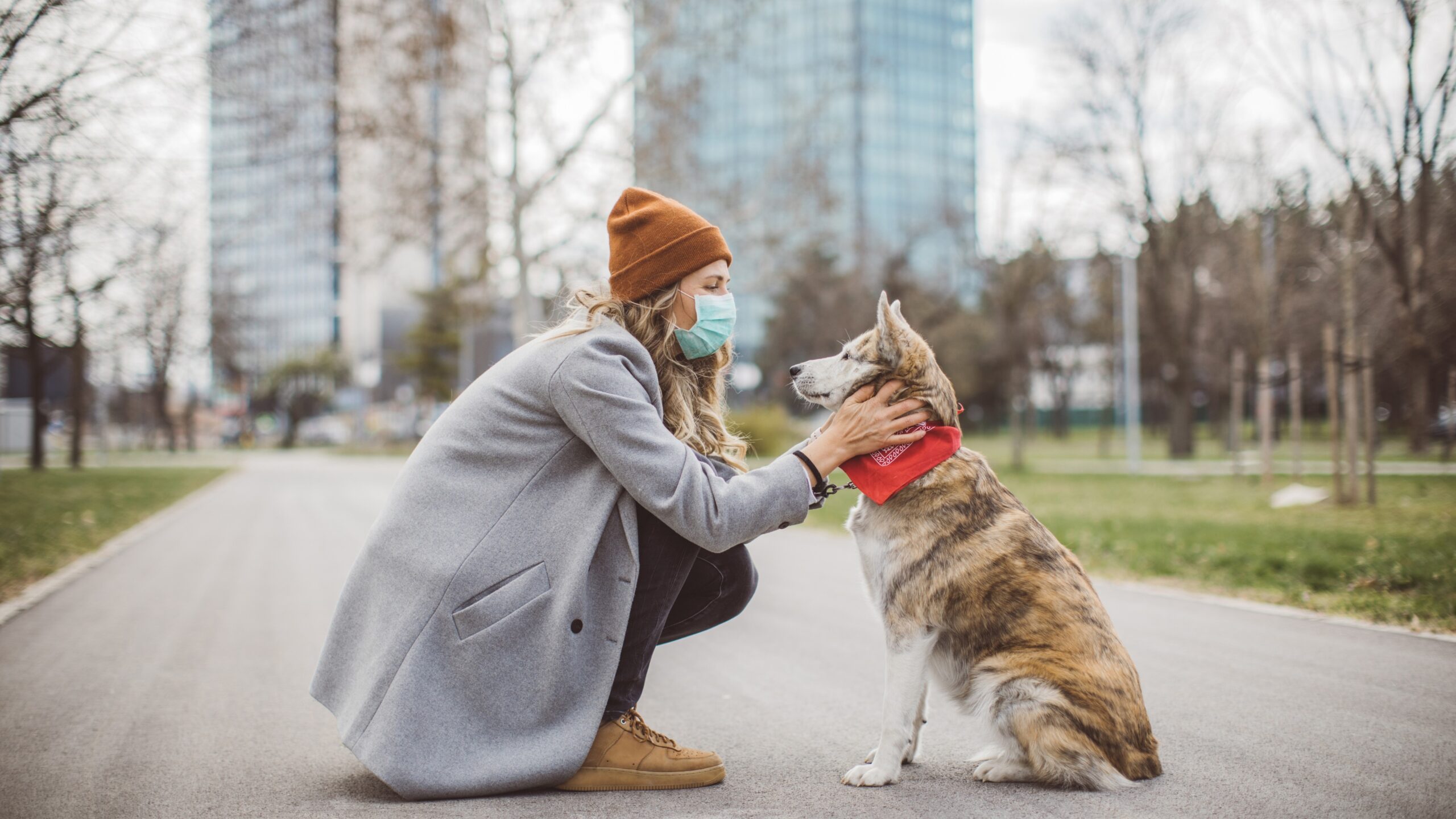
We are not the only ones with stress, anxiety, and fear in our house. Our pets experience the same feelings. The pandemic brought a surge in pet adoptions and now many COVID pups may be going feeling separation anxiety now that owners are going back to the office, for example.
As Smithsonian Magazine reports, a study published in the journal Scientific Reports evaluated nearly 14,000 dogs — the largest ever study on canine temperaments — and showed that nearly three-fourths of the pets showed at least one anxiety-related behavior, with some variation across breed. That’s 72.5% exhibiting at least one anxiety-related behavior.
LittleThings spoke with Kenneth Martin, DVM, Elite Fear Free Certified Professional, about anxiety and fear in dogs.
“Separation anxiety or distress is perhaps one of the most common behavior problems of dogs,” shares Dr. Martin. “Anxiety and fear are two different things. However, their behavioral presentations overlap and may be indistinguishable from the pet owner’s perspective.”
The Difference Between Anxiety and Fear
Dr. Martin says, “Fear can be defined as an aversive emotional state consisting of physiological, psychological, and behavioral responses to a real and present or perceived threat or danger. Fear can be adaptive and motivate the dog to avoid situations or interactions that might be dangerous. While fear can be a normal emotion, the behavior can become extreme for the given circumstance or level of threat experienced by the individual.”
On the other hand, Dr. Martin says, “Anxiety can be defined as a diffuse generalized feeling of fear, apprehension, unease or nervousness regarding an imminent event, uncertain outcome, or danger (threat). While fear is an emotional response to a real and present or perceived threat or danger, anxiety is the emotional response that occurs with anticipation of the presentation of the stimulus that induces fear. Anxiety occurs with the anticipation of an undesirable imminent event or worry about an uncertain outcome through previous learning experiences and higher order conditioning.”
Dr. Martin notes, “Anxieties may build up gradually over an extended period of time and last for an extended duration of time. With generalized anxiety, the trigger or antecedent is sometimes unidentifiable. The dog may be restless, anxious, and unsettled over an extended period of time even in a familiar environment, with familiar persons, or with the presentation of multiple social or environmental stimuli that are unavoidable. Conversely, with situational anxiety, the trigger is often identifiable, such as social anxiety and anticipating the arrival of people to the home or separation anxiety and anticipating the departure of familiar people from the home."
Dr. Martin also discussed diagnosing fear and anxiety, "Canine body language must be evaluated with respect to the context or situation in which they are expressed. Body language in the absence of context has little value. Rather than focusing on just one body part or clinical sign, it is important to look for and identify multiple signs, from head to tail, which can indicate feelings of fear, anxiety, or stress in the dog."
8 Signs Your Dog Is Experiencing Fear or Anxiety
Here’s what to watch for in your dog’s body language according to Dr. Martin:
- Head: Lowered, held down below the topline, turned away from the stressor
- Mouth: Lip licking, yawning, chattering jaw, panting or held tightly closed, smiling with retracted lips
- Eyes: Dilated pupils, whale eye (whites of eyes exposed), shifting gaze, feigning sleep, avoiding eye contact (looking away)
- Ears: Flattened/pinned close to head, retracted from erect conformation or from a more forward position in floppy eared breeds
- Tail: Lowered below the topline, held close to the body or tucked tightly between legs
- Body position: Cowering (crouched or lowered topline), rolling over (belly up), C-shaped, frozen in place, or leaning away
- Hair/coat: Piloerection over neck, topline, or rump, excessive shedding
- Conflict/displacement behavior: Scratching, leg lifting behavior or urine marking, mounting, raised foreleg, or play bow
“Behavioral responses may include panting and drooling,” adds Dr. Martin. “Saliva increases in viscosity and swallowing may be diminished. Vomiting and inappetence may occur. Dogs do not eat well when stressed. Stress may produce nausea and stomach upset leading to vomiting and a lack of appetite. Dogs with chronic anxiety related conditions often have gastrointestinal sensitivity, and difficult maintaining a healthy body weight. Vocalizations in the form of high-pitch whining, distress barking, and howling may occur with chewing and scratching of objects leading to destructive behavior.”
He notes that dogs may have changes in toileting behavior with fear, anxiety, and stress, including house soiling in a previously housetrained dog, urine marking, submissive (fear related) urination, excitement urination, and anal sac expressions.
Destructive behavior may also be associated with fear and anxiety. “These may include mouthing or biting, chewing, digging, or scratching of objects in the dog’s environment,” says Dr. Martin. “Destructive behavior may result in accidental self-injury or it may be directed toward oneself with self-injurious behaviors. Dermatological conditions such as acral lick dermatitis are often associated with behavioral problems, including fear, anxiety, and stress.”
5 Tricks to Keep Your Dog Stimulated
“For dogs to thrive and not just survive, we must establish a routine of enrichment activities and interactions,” instructs Dr. Martin. “Environmental enrichment for our pets is mandatory, not optional. It is imperative for their physical and emotional well-being. Enrichment should be geared toward meeting the dog’s exploratory, physical and social needs.”
He suggests:
1. Offer food puzzle toys.
Food puzzle toys for delivering meals are one example of providing exploration. Rotating toys in the environment will keep them novel and more interesting.
2. Foster search and hunt behaviors.
Teaching dogs how to search for their food or even for a favorite toy can make for great fun, engaging the dogs primary sense organ, their nose. Provide an outlet for this search behavior through a find-it game.
Dr. Martin notes, “In multi-pet households, some dogs may show aggression toward other pets in the home over toys or food items, so take precautions when introducing these items. It may be best to provide toys and food items only when the pets are not together to minimize social competition, stress, and the risk of injury.”
3. Take a sniff walk.
This is an on-leash walk with the dog allowed to and periodically encouraged to “go smell.” The dog is praised for checking out an interesting scent. If the owner needs to move on before the dog has finished smelling, the dog can be cued and reinforced with a small treat for moving along with the owner.
4. Take leash walks, ideally off the property.
Two short (five to 10 minutes) on-leash walks with the owner offers opportunities for physical exercise, social interactions with the owner, and exploration. New sights, sounds, and smells are intriguing for most pets, especially if introduced to walks and novelty when young.
Moderate exercise is good for most dogs; strenuous exercise is not necessary and may be physically harmful or medically detrimental. In young dogs, the stress of excessive exercise on developing joints can be detrimental and in older pets it can cause pain or discomfort if arthritis is present.
5. Engage in social play with the dog.
Developing a play relationship based on trust and understanding can facilitate a strong bond between owners and their dogs. Some of the best types of play are with size-appropriate tug toys. The chase it or tug toy may be on the end of a flirt pole. This allows both dog and owner to engage in interactive play. Appropriate play with a tug toy will not make a dog aggressive but may not be appropriate for dogs with resource guarding behaviors. It can provide an appropriate outlet for predatory behavior in certain breeds and help to teach impulse control. Play needs to be modified appropriately to prevent overarousal and possible accidental injury to the dog or owner.
Beware of dog parks. Dr. Martin notes, “For dogs with fear issues or poor social skills, there is the risk of interdog aggression and social encounters might induce fear, anxiety, and distress.”
To sum it up, developing a predictable routine for pets provides them with security and gives them a sense of stability.
Dr. Martin says, “For most dogs, have a routine for schedule meals, walks, training and other forms of social interaction. Ideally, dogs should have the opportunity for a minimum of one or two short walks and/or play sessions with their owner each day, two short training sessions a day, and at least two opportunities for exploratory activities a day, which could include feeding the dog a meal in a food puzzle toy.”
Spending more time with your dog will help you relax more, too!




